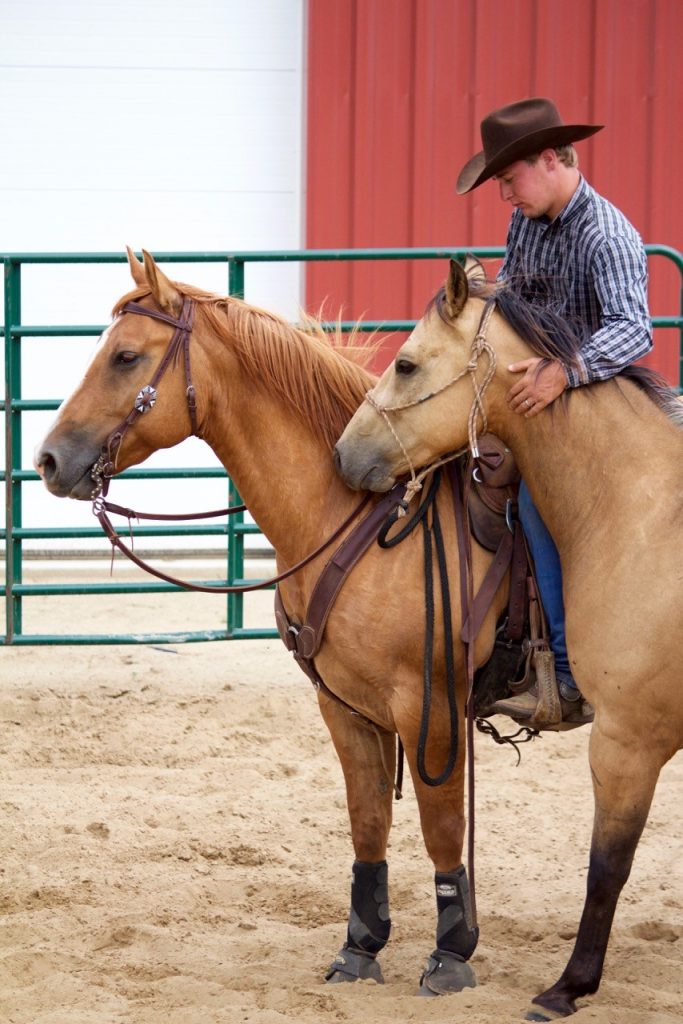
Success in the Saddle: Ponying Horses
When it comes to working with our horses and building up their confidence, ponying can be a great way to work toward those goals. From leading a pack horse with a job to do, to simply getting a young horse more experience and handle, ponying is a great way to help in our horsemanship journey.
In our program, one area we use ponying a lot is to provide our young horses the experience necessary to ensure that by the time we get on their backs we have already laid down a foundation to set them up for success.
Why is ponying beneficial?

When it comes time to ride our horses, the more we’ve had a chance to expose them to, the less likely we are to have reactive horses.
When it comes to working with young horses, it is important to break things down for them in a manner that helps them digest smaller pieces of the bigger picture. When we push the whole idea or goal we have for them all at once, it can usually be too much for them mentally and cause unnecessary emotion that we could have avoided. When it comes time to ride our horses, the more we’ve had a chance to expose them to, the less likely we are to have reactive horses.
Going beyond young horses, ponying can also assist with a nervous horse of any age, or perhaps to work through some sort of problem better done out of the saddle. Using an already good-minded horse to pony a nervous or young horse provides stability for your pony horse and builds up their confidence as well as your own.
Preparing Your Saddle Horse
In order to successfully and safely pony a horse, it takes preparation for not only the ponied horse but your saddle horse as well.
Starting with your saddle horse, you want to make sure he is sacked out to a rope on and around him as it would be when there will be another horse at the end of it. By being in a round pen, you can safely do this with your horse and a rope by rubbing him down with the rope, adding pressure and release until he is relaxed and accepting of the rope. Then take your rope and, while mounted, drag the rope along while you walk your horse around the pen. This will teach him to accept something touching him on his legs or anywhere on his hip.
Having body control of your saddle horse is important to your ponying experience as well. You must be able to move his hips, shoulders, and rib cage off of leg pressure. Responsiveness in the bit and the ability to ride one-handed with a neck rein is important as well to the overall control needed for ponying a horse.
Preparing Your Pony Horse
Once you have your saddle horse well prepared, you can then do a few things to help prepare your pony horse. It is important that your pony horse at least has an understanding of respectful ground manners. Take some time to also go through your groundwork to make sure your pony horse understands the cues to moving his body around from the ground in a halter and lead.
After working with a young horse as your pony horse and moving beyond the first stages of saddling, adding a saddle can help your young horse gain even more confidence and result in a confident and broke horse.

Tips to Ensure a Safe and Successful Ponying Experience
Ponying is a great tool to learn and practice, but there are some important safety practices and tips to keep in mind.
- Always keep your head on a swivel. This means watching forward where you want to ride as well as watching behind you at what your pony horse is doing.
- If by any chance your pony horse were to start getting a little worked up behind you and you needed to get in a better position to control the situation, always turn your saddle horse toward your rope in your hand so as not to entangle yourself.
- If you find yourself in a more serious situation, dropping your rope and turning toward it will prevent the saddle horse from getting tangled. Practicing coordination with your hands and a rope beforehand is always a good idea prior to ponying for the first time.
Keeping these safety practices and tips in mind can help lead to a successful ponying experience.
Ponying can be a great overall experience for both you and your horses. When using it wisely and safely, you can use ponying to build confidence, experience, and control in your horses. These attributes can all help in your horsemanship journey, leading to a closer partnership and aiding in the process of achieving your horsemanship goals.
Written by Christiana Wenger of C & C Horsemanship








